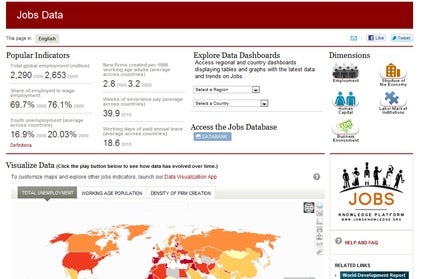The need for more and better data is a key message coming out of the new 2013 World Development Report on Jobs. Certainly timely jobs data can inform policy areas as diverse as drafting fiscal policy, designing labor market and social protection policies, and targeting public expenditures. Expanded data on jobs can also contribute to global knowledge about which types of policies have successfully created good jobs in the past. Yet for too many countries and years, data is incomplete, unavailable, or inaccessible.
Filling these holes would require modifying existing survey instruments by adding questions or enlarging samples – although extra resources would be needed. Fortunately, two other holes exist that would be easier to fill. One is to bring together data from different sources so that a more holistic multi-sectoral approach to understanding the jobs agenda is possible. The other is then making this existing data more easily available. The JKP is working on these two other fronts.
Major holes in data
Some of the biggest data gaps are:
- Links between poverty dynamics and income earning opportunities. Getting a job is the most common pathway out of poverty, yet few national surveys follow the same individuals or households over longer periods of time – and few capture systematically the most common forms of “jobs,” namely, self-employment and microentrepreneurship.
- The full spectrum of enterprises. Firm surveys focus on formal and larger firms, but few surveys allow for analyzing transitions between informality and formality, and from micro-entrepreneurship to becoming a small or medium enterprise.
- Comparable measures of a wider set of policies that affect jobs. Data on business regulations, including labor ones, are included in the World Bank’s Doing Business. But the set of relevant policies is wider and should be captured systematically - such as those covering land rights and agricultural policies, infrastructure and urbanization, education and training, migration, and banking and governance.
- Additional dimensions in which jobs may matter. Jobs contribute not only to higher income (and related benefits) and productivity but also better intra-household bargaining, self-worth, and engagement with the community.
A complete picture also calls for a multi-sectoral approach
To get a complete understanding of the constraints and opportunities for job creation, the jobs data agenda calls for improving coordination between two approaches:
(1) The viewpoint of current or prospective workers (household or labor force surveys). This tends to focus on skills and determinants of labor force participation. Key policies include approaches to education and training and to labor regulations.
(2) The viewpoint of current or potential employers (enterprise surveys). This tends to focus on factors that influence firm entry, technology choices, competitiveness, and the demand for skills. Key policies include a larger spectrum of regulations that affect the business environment, infrastructure, the financial system, the rule of law, and macroeconomic conditions. Our Jobs Data Page does just this. Variables are grouped by theme, but can be viewed together – on country and regional dashboards or in interactive data visualization tools.

Example one. How does a country's trade openness and degree of urbanization affect the density of new business creation? If we plot these variables in a scatter plot chart (see Figure 1), a few patterns stand out. First, countries with higher rates of exports are relatively urbanized. Second, the density of new firm creation (captured by the size of the bubble) is generally higher in more urbanized economies. Third, while the high exporters have higher rates of firm entry, this pattern does not hold across the board; other than at the high end, there is only a weak relationship between overall trade and firm entry. Whether the relationship might vary with the content of trade, i.e. manufacturing exports rather than commodity exports, is a further hypothesis that could be explored. But Figure 1 indicates urbanization rather than trade openness per se is associated with higher rates of firm entry.

Example two. What about policies that are expected to affect incentives for firms to enter and grow? How does the ease of doing business in a country and the level of its minimum wage affect firm and job creation? If we plot these variables (see Figure 2), we see that new business entry is higher where regulations are more business-friendly (with causation potentially running in both directions). However, there is no clear correlation with minimum wages - either with the general measure of business regulations or with firm entry.

Of course, data visualization isn't a substitute for a more rigorous analysis that tests a hypothesis and controls for other relevant variables, but it can provide insights into basic correlations across groups of variables.
Improving access to data that does exist
As for the need for the data that does exist to be made more accessible, the Open Data Initiative spearheaded by the World Bank, is committed to do just that, in part through the Jobs Data Page. This data is also now available for mobile devices - with iOS and Android apps: Job Datafinder. The agenda to collect more data and to make it accessible will continue, and comments on what to prioritize are welcome. The JKP and its members hope to be integral partners in this process.
This post was first published on the Jobs Knowledge Platform.


Join the Conversation